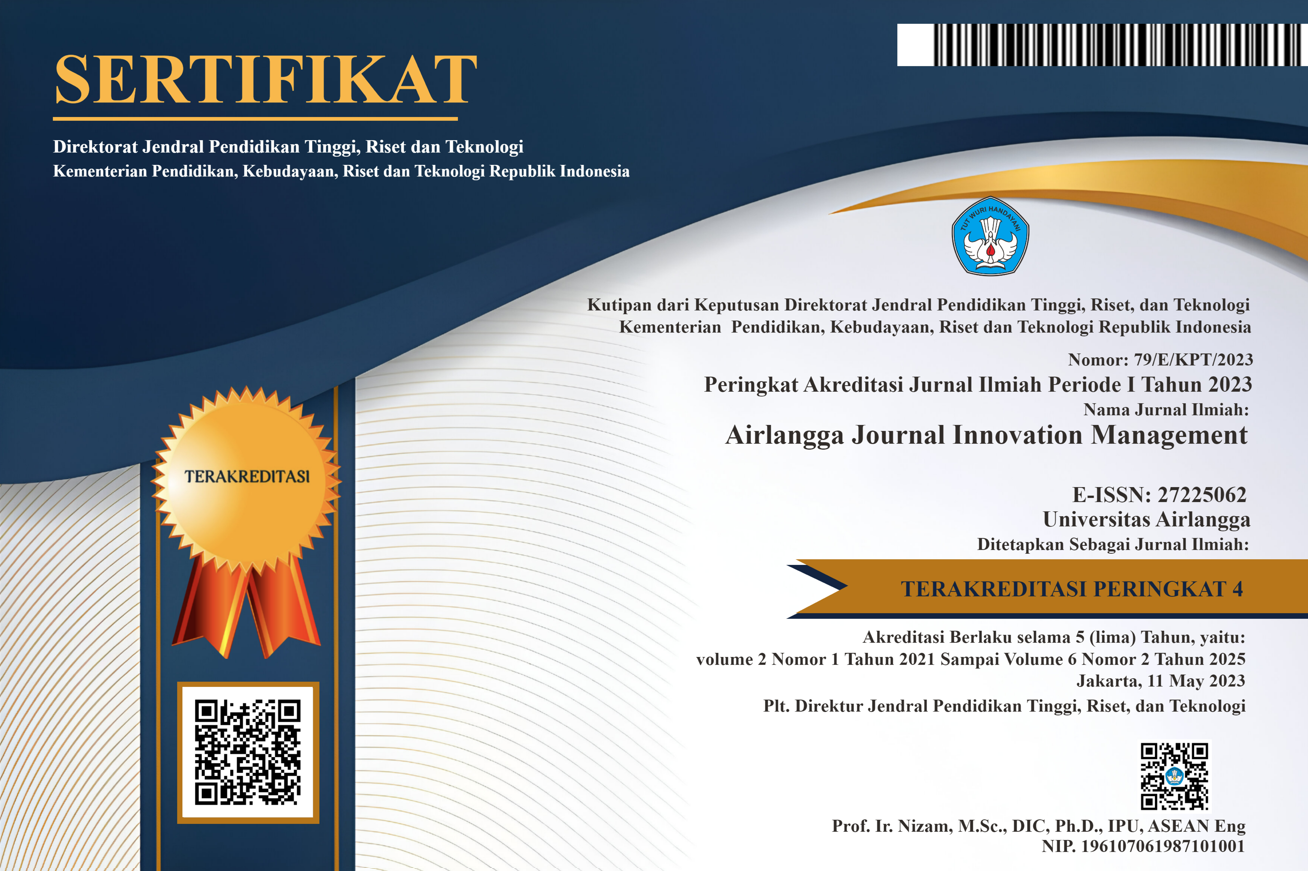Application of Fish Probiotics in Catfish Farming Activities using Biofloc System: Low and High Protein Feed Induction
Downloads
Catfish farming with the biofloc system is increasingly used because it can increase feed efficiency. However, the main challenge in this system is optimal water quality, especially in relation to the presence of pathogenic bacteria such as coliform. This study aims to determine the effect of giving probiotics to feed with high, low, and control protein content on water quality, water and intestinal TPC, and the level of coliform bacteria in the anus of catfish. The method used in this study is experimental in the laboratory of Trunojoyo Madura University. This research was carried out using 3 treatments, namely control, low, and high protein feed. Data related to the results of measuring water quality parameters pH, temperature are presented in the form of a graph. The results data for detecting pathogenic bacteria in sangkuriang catfish (Clarias gariepinus) were analyzed qualitatively by calculating the Total Plate Count (TPC) value of heterotrophic bacteria growing in Nutrient Agar (NA) media and pathogenic bacteria growing in Eosin Methylene Blue Agar (EMBA). The results of this study are expected to provide a better understanding of how the use of probiotics affects. Temperature values ranged from 26.71-28.83°C, and pH ranged from 8.34-9.45. Bacterial TPC values ranged from 8.03 to 16.94 CFU/ml. The TC value of bacteria in catfish anus samples ranged from 3.81-7.00 CFU/ml. This study can be a practical solution for farmers to improve sustainable catfish cultivation
Ahmad, N., Martudi, S., & Dawami, D. (2017). Pengaruh Kadar Protein yang Berbeda Terhadap Pertumbuhan Ikan Gurami (Osphronemus gouramy). Jurnal Agroqua, 15(2), 51–58.
ANNISA, K. N., & AFFANDI, R. I. (2024). Pemeliharaan Ikan Lele Dumbo (Clarias Gariepinus) Pada Kolam Beton. Ganec Swara, 18(3), 1272. https://doi.org/10.35327/gara.v18i3.933
Arivo, Debi, Annissatussholeh, & Nurul. (2017). Pengaruh tekanan osmotik pH, dan suhu terhadap pertumbuhan bakteri Escherichia coli. Jurnal Ilmu Kedokteran Dan Kesehatan, 4(3), 153–160.
Baihaqi, B., Abdul Latief, Agus Putra AS, & Adi Bejo Suwardi. (2020). Pemberdayaan Pokdakan Tanah Berongga-Sido Urep Melalui Budidaya Lele Bioflok Autotrof di Kabupaten Aceh Tamiang. Jurnal Pengabdian UntukMu NegeRI, 4(2), 180–186. https://doi.org/10.37859/jpumri.v4i2.2103
Bayu, B., & Sugito, S. (2017). ANALISIS KADAR DERAJAT KEASAMAN (pH) DALAM PEMELIHARAAN IKAN HIAS KOKI PADA MEDIA TANAMAN HIAS AIR DENGAN PENAMBAHAN NONILFENOL. Buletin Teknik Litkayasa Akuakultur, 15(1), 25. https://doi.org/10.15578/blta.15.1.2017.25-28
Carladiva, C. (2024). Permintaan Ikan Lele di Pasar Karimun Meningkat. Redaksi.
Ciptawati, E., Budi Rachman, I., Oktiyani Rusdi, H., & Alvionita, M. (2021). Analisis Perbandingan Proses Pengolahan Ikan Lele terhadap Kadar Nutrisinya. IJCA (Indonesian Journal of Chemical Analysis), 4(1), 40–46. https://doi.org/10.20885/ijca.vol4.iss1.art5
De Schryver, P., Crab, R., Defoirdt, T., Boon, N., & Verstraete, W. (2008). The basics of bio-flocs technology: The added value for aquaculture. Aquaculture, 277(3–4), 125–137. https://doi.org/10.1016/j.aquaculture.2008.02.019
Djauhari, R., Siburian, E. L. S., Wirabakti, M. C., Monalisa, S. S., & Christiana, I. (2022). KINERJA PERTUMBUHAN IKAN GABUS (Channa striata) YANG DIBERI PREBIOTIK MADU DAN PROBIOTIK Lacticaseibacillus paracasei. Jurnal Perikanan Unram, 12(3), 457–466. https://doi.org/10.29303/jp.v12i3.344
Duncan, S. E., & Hannah, S. (2012). Managing the microbiota in aquaculture systems for disease prevention and control. 303–322.
Faridah, F., Diana, S., & Yuniati, Y. (2019). Budidaya Ikan Lele Dengan Metode Bioflok Pada Peternak Ikan Lele Konvesional. CARADDE: Jurnal Pengabdian Kepada Masyarakat, 1(2), 224–227. https://doi.org/10.31960/caradde.v1i2.74
Fauziyah, N., Nirmala, K., Supriyono, E., & Hadiroseyani, Y. (2019). EVALUASI SISTIM BUDIDAYA LELE: ASPEK PRODUKSI DAN STRATEGI PENGEMBANGANNYA (Studi Kasus: Pembudidaya Lele Kabupaten Tangerang). Jurnal Kebijakan Sosial Ekonomi Kelautan Dan Perikanan, 9(2), 129. https://doi.org/10.15578/jksekp.v9i2.7764
Ferdian, F., Maulina, I., & Rosidah. (2012). Analisis Permintaan Ikan Lele Dumbo (Clarias Gariepinus) Konsumsi di Kecamatan Losarang Kabupaten Indramayu. Jurnal Perikanan Dan Kelautan, 3(4), 93–98.
Hariani, D., & Purnomo, T. (2017). Pemberian Probiotik Dalam Pakan Untuk Budidaya Ikan Lele. STIGMA: Jurnal Matematika Dan Ilmu Pengetahuan Alam Unipa, 10(01), 31–35. https://doi.org/10.36456/stigma.vol10.no1.a582
Hidayati, N., Sukmana, D. J., Ariami, P., Urip, U., & Fihiruddin, F. (2024). Pengaruh Penambahan Glukosa terhadap Pertumbuhan Bakteri Escherichia coli pada Media Pemupuk Nutrient Broth (NB). JSN : Jurnal Sains Natural, 2(2), 48–52. https://doi.org/10.35746/jsn.v2i2.538
Himawan, R. G., Primarizky, H., Mafruchati, M., Triakoso, N., & Maslachah, L. (2021). Green Tea Leaves Extract Effect on Histopathology of Mercury Chloride Induced Rat’s Liver. Pollution Research, 40(1), 326–329.
KKP WEB DJPB. (2021). KOMODITAS LELE JADI PRIMADONA MASYARAKAT, KKP PACU PRODUKSI NASIONAL MELALUI SISTEM BIOFLOK.
Kurniawan, I., Saloko, S. A., & Aji, W. A. (2021). Pelatihan Budidaya Lele Dalam Kolam Terpal Bulat Untuk Keterampilan Warga Binaan Di Lapas IIB Sleman. Seminar Nasional Hasil Pengabdian Kepada Masyarakat Tahun 2021, 1–7.
Kurniawan, W. (2023). Sistem Monitoring Ph dan Suhu Air pada Kolam Ikan Lele Terintegrasi Berbasis Internet Of Things (Monitoring System For Ph and Water Temperature in Catfish Pond Based on Internet Of Things). 10(3), 2137.
Lado, F. U., Kale, P. R., & Sabtu, B. (2017). EFEK PENGGUNAAN MADU TERHADAP pH , TPC , BAKTERI ESCHERICHIA COLI DAN SALMONELLA DAGING BROILER ASAP. Jurnal Nukleus Peternakan, 4(1), 22–30.
Laili, N. H., Abida, I. W., & Junaedi, A. S. (2022). Nilai Total Plate Count (TPC) Dan Jumlah Jenis Bakteri Air Limbah Cucian Garam (Bittern) Dari Tambak Garam Desa Banyuajuh Kecamatan Kamal Kabupaten Bangkalan. Juvenil:Jurnal Ilmiah Kelautan Dan Perikanan, 3(1), 26–31. https://doi.org/10.21107/juvenil.v3i1.15075
Linayati, L., Aji Prasetyo, T., & Yusufi Mardiana, T. (2021). PERFORMA LAJU PERTUMBUHAN IKAN BANDENG (Chanos chanos) YANG DIBERIKAN PAKAN DENGAN PENGKAYAAN PROBIOTIK. Jurnal Litbang Kota Pekalongan, 20(1), 64–71. https://doi.org/10.54911/litbang.v20i.146
Lumbangaol, D., Aryasatya, R., Zainuri, M., Studi, P., Sumberdaya, M., Pertanian, F., Madura, U. T., & Timur, J. (2024). Pengaruh Pemberian Probiotik Ikan Terhadap Kualitas Air Pada Pendederan Ikan Lele Sangkuriang ( Clarias Gariepinus ) Di Desa Durbuk , Pamekasan. Journal.Trunojoyo, 5(2), 125–137.
Luqman, E. M., Mafruchati, M., Rahardjo, B. P. S., & Hestianah, E. P. (2019). Crosstalk between Necrosis and Apoptosis of Embryonal Cerebral Cortex Neuron Mice (Mus musculus) Caused by Carbofuran Exposure. Research Journal of Pharmacy and Technology, 12(11), 5492–5498.
Ma’ruf, I. (2019). Budidaya Lele Sistem Bioflok Solusi Ketahanan Pangan Masyarakat Perkotaan. Societa, 5(2), 83–86. https://doi.org/10.32502/jsct.v5i
Mafruchati, M., & Ismail, W. I. W. (2023). The Aqueous Leaf Extract of Moringa Oleifera had Immunomodulatory Effects on Sheep that had Been Infected by Fasciola Gigantica, Clostridium Novyi Naturally and Impact to Fasciola gigantica Non-Embryonated. Pharmacognosy Journal, 15(2).
Mafruchati, M., Ismail, W. I. W., Wardhana, A. K., & Fauzy, M. Q. (2023). Bibliometric analysis of veterinary medicine on embryo of animals in textbook in conceptualizing disease and health. Heliyon.
Mafruchati, M., Othman, N. H., & Wardhana, A. K. (2023). Analysis of the Impact of Heat Stress on Embryo Development of Broiler: A Literature Review. Pharmacognosy Journal, 15(5).
Mafruchati, M., Wardhana, A. K., & Ismail, W. I. W. (2022). Disease and viruses as negative factor prohibiting the growth of broiler chicken embryo as research topic trend: a bibliometric review. F1000Research, 11(1124), 1124.
Merrifield, D. L., Dimitroglou, A., Foey, A., Davies, S. J., Baker, R. T. M., Bøgwald, J., Castex, M., & Ringø, E. (2010). The current status and future focus of probiotic and prebiotic applications for salmonids. Aquaculture, 302(1–2), 1–18. https://doi.org/10.1016/j.aquaculture.2010.02.007
Muarif, M. (2016). Karakteristik Suhu Perairan Di Kolam Budidaya Perikanan. Jurnal Mina Sains, 2(2), 96–101. https://doi.org/10.30997/jms.v2i2.444
Munggaran, G., A., Asri, H., A., & Pajrina, D., P. (2024). Gambaran Kualitas Air di Situ Tujuh Muara Kecamatan Bojongsari Kelurahan Bojongsari Kota Depok. Jurnal Promotif Preventif, 7(3), 402–408.
Nayak, A. K. (2010). Probiotics and immunity: A fish perspective. International Journal of ChemTech Research, 29(1), 2–14.
Noviana, P., Subandiyono, & Pinandoyo. (2014). The Effect of Probiotics in Practical Diets on the Diet Consumption and Growth Rate of Tilapia (Oreochromis niloticus) Juvenile. Journal of Aquaculture Management and Technology, 3(4), 183–190.
Nursobah, N., Salmon, S., Lailiyah, S., & Sari, S. W. (2022). Prototype Sistem Telemetri Suhu Dan Ph Air Kolam Budidaya Ikan Air Tawar (Ikan Nila) Berbasis Internet of Things (Iot). Sebatik, 26(2), 788–797. https://doi.org/10.46984/sebatik.v26i2.2053
Putra, I., Rusliadi, R., Pamukas, N. A., Suharman, I., Masjudi, H., & Darfia, N. E. (2022). PERFORMA PERTUMBUHAN IKAN NILA MERAH, Oreochromis niloticus PADA SISTEM BIOFLOK DENGAN FREKUENSI PEMBERIAN PAKAN YANG BERBEDA. Jurnal Riset Akuakultur, 17(1), 15. https://doi.org/10.15578/jra.17.1.2022.15-21
Sari, L. P., Humairani, & Mayasari, S. (2022). Efisiensi Teknis Usaha Budidaya Ikan Lele (Clarias sp.): Studi Kasus di Kelurahan Srimulya Kecamatan Sematang Borang Kota Palembang. Jurnal Il,Mu-Ilmu Perikanan Dan Budidaya Perairan, 17(2), 2503.
Siswanto, T. A., & Rony, M. A. (2018). Aplikasi Monitoring Suhu Air Untuk Budidaya Ikan Koi Dengan Menggunakan Mikrokontroller Arduino Nano Sensor Suhu Ds18B20 Waterproof Dan Peltier Tec1-12706 Pada Dunia Koi. Skanika, 1(1), 40–46.
Sunarma, A. (2004). Peningkatan produktifitas usaha lele sangkuriang (Clarias sp.). Departemen Kelautan Dan Perikanan. Direktorat Jenderal Perikanan Budidaya.
Suriani, S., Soemarno, & Suharjono. (2013). Effect of temperature and pH on the growth rate of Five Bacterial Isolates Members of the Pseudomonas isolated from the Detergents Contaminated River Ecosystem around the UB Campus. J-Pal, 3(2), 59–62.
Telaumbanua, B. V., Telaumbanua, P. H., Lase, N. K., & Dawolo, J. (2023). Penggunaan Probiotik Em4 Pada Media Budidaya Ikan: Review. TRITON: Jurnal Manajemen Sumberdaya Perairan, 19(1), 36–42. https://doi.org/10.30598/tritonvol19issue1page36-42
Wu, Z. B., Gatesoupe, F. J., Li, T. T., Wang, X. H., Zhang, Q. Q., Feng, D. Y., Feng, Y. Q., Chen, H., & Li, A. H. (2018). Significant improvement of intestinal microbiota of gibel carp (Carassius auratus gibelio) after traditional Chinese medicine feeding. Journal of Applied Microbiology, 124(3), 829–841. https://doi.org/10.1111/jam.13674
Yuriana, L., Santoso, H., Sutanto, A., Magister, M., Biologi, P., Metro, U. M., & Magister, D. (2017). Pengaruh Probiotik Strain Lactobacillus Terhadap Laju Pertumbuhan dan Efisiensi Pakan Lele Masamo (Clarias sp) Tahap Pendederan I dengan Sistem Bioflok Sebagai Sumber Biologi. Jurnal Lentera Pendidikan Pusat Penelitian LPPM UM Metro, 2(1), 13–23.
Copyright (c) 2025 Airlangga Journal of Innovation Management

This work is licensed under a Creative Commons Attribution-NonCommercial-ShareAlike 4.0 International License.
- The journal allows authors to hold copyright without restrictions and retain publication rights without restrictions. The author retains the copyright and grants the first publication rights to the journal, with his work simultaneously licensed under the Creative Commons Attribution-NonCommercial-ShareAlike 4.0 International License (CC BY-NC-SA). This license allows others to share the work with acknowledgment of authorship and initial publication in this journal, provided that the work is not used for commercial purposes and that any derivative works must use the same license.
- Authors may enter into additional contractual agreements for non-exclusive distribution of the journal publication version (e.g., uploading it to an institutional repository or publishing it in book form), while still including acknowledgment of the initial publication in this journal.
- Authors are allowed and encouraged to upload their work online (e.g., in an institutional repository or personal website) before and during the submission process. This can support productive scientific exchanges as well as increase citations to published works.

AJIM by UNAIR is licensed under a Creative Commons Attribution-NonCommercial-ShareAlike 4.0 International License.





















